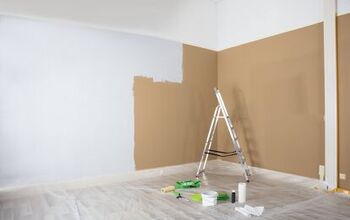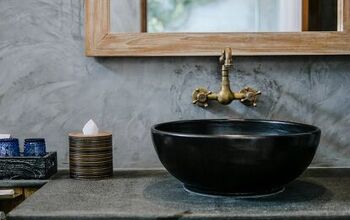Can You Paint Over Wallpaper Glue? (Find Out Now!)

We all have that one wallpaper in our homes that’s been there since before we were born, but let’s face it, it’s time for an upgrade. 70s wallpaper is just not your thing, so you removed it, and now there’s a ton of dried-up wallpaper glue all over your walls. Do you have to remove it or can you paint over wallpaper glue?
You should not paint over wallpaper glue because the paint will reactivate the glue creating a wavy, sticky texture on your walls. Most paints are water-based and so is wallpaper glue, which is what causes the glue to reactivate. If you attempt to paint over wallpaper glue, use an oil-based primer and multiple thin coats of paint. Also, allow the paint to fully dry in between coats.
While you can paint over a bunch of things, wallpaper glue does not belong to that club. Wallpaper glue is tough to remove, but it’s always doable. This guide will help you understand why painting over wallpaper glue is typically a major no-go.
Do You Need to Hire a Paint Contractor?
Get free, zero-commitment quotes from pro contractors near you.

Why Can’t You Paint Over Wallpaper Glue?
Wallpaper glue is one of the most durable, ticky-tacky things that you can buy. There are two main reasons why you should never paint over wallpaper glue. These are as follows:
- The wallpaper glue can be reactivated by latex-based primers and paints. This will cause the glue to make it impossible for the paint to adhere to your walls, leaving a smeary, gross mess everywhere.
- The glue can also make your paint look uneven. Even if it doesn’t reactivate, there’s something to be said about paint that doesn’t look even or smoothly painted on. This is a common gripe as far as painting over wallpaper glue goes. After all, drywall tends to break and chip when you pull the wallpaper off of it.
- It will increase your workload. Just don’t do it. You’ll spend more time working to fix the mistakes than you will spend actually painting.
- It can cause a poor paint job. When you paint directly over wallpaper glue, it can affect the drying of your paint. YOur paint won’t fully adhere, and you can expect chips and peeling paint down the road.
What Kind Of Paint Can You Use Over Wallpaper Glue?
Technically, you can use any kind of paint as long as you properly prepare the walls. This includes a lot of removal of glue and making sure to remediate everything that you need to. To ensure that you get the best results possible, use an oil-based primer. This will ensure that the glue gets sealed in and will not harm the paint.
The more important thing to do is to work with paints and primers that come from reputable companies. A high-quality paint will be less likely to run or get uneven than a low-quality one. Since the primer and paint quality matters so much more here, this is one thing that you absolutely should splurge on.
What Kind Of Primer You Should Use?
When you’re working with walls that were covered in wallpaper paint, you need to make sure that you have a primer that won’t react to the paint. The best primer for this issue is an oil-based primer that is specially designed for problematic surfaces. We suggest that you get one from Sherwin Williams, since they tend to have a good reputation for their problem surface primers.
How To Prep Your Walls For Paint After Removing Wallpaper
So, it’s clear that painting over wallpaper paint is not something you should aspire to do. It’s just not a good idea, and it will wreck your walls. But, how do you make your painting doable? This is what you’re going to need to do…
- First things first, you will need to remove the wallpaper. The best way to do this is with a wallpaper steamer or a handheld steamer. Peel off the offending paper and toss it out.
- Once all the paper is removed, wipe down the walls with warm water and a sponge. You will need to scrub pretty heavily to make it all go away. In some cases, you may need to treat the walls as if you’ve stained them with cigarette nicotine. We suggest using TSP if water alone will not dissolve the glue. You can also try a mixture of hot water, one cup of vinegar, and 1 teaspoon of dish soap, or hot water mixed with fabric softener.
- After dissolving the glue, sand down your walls. Most wallpaper glues will sink into the walls to a point. In order to ensure that you get the best results, you will need to sand down the area with 100-grit sandpaper. Once everything is sanded down, wipe off the dust with a tack cloth or some warm water. Make sure to remove all dust before the next step.
- If any areas have been torn due to wallpaper removal, add drywall mud or wood filler (depending on the material of your walls) to patch things up. This will give your walls the perfectly smooth look people adore and will also help ensure that your walls stay sturdy and chip-free.
Next Comes The Primer
- Grab an oil-based primer and give your walls a coat of it. You have to make sure it’s oil-based, otherwise, you’ll end up with a primer that can’t prime. Ideally, you’ll use more than one coat, simply because wallpaper glue is really that bad.
- Wait at least two hours for it to dry before you start painting the walls. Your primer can will tell you how long you need to wait until you’re ready to paint.
Note: Use a sealant on any paint that goes over a wall that used to have wallpaper glue. The sealant will ensure that you don’t have any cracking or chipping.
Should You Hire Professional Painters?
Most people can have a fun time painting their walls and get great results. After all, painting is not that hard a thing to do. As long as you have painter’s tape, you should be good to go in most cases. With walls that previously had wallpaper, that’s not always going to be the case if you DIY it.
A lot of people who attempt to get rid of the wallpaper glue from their walls find out that painting it isn’t easy. In fact, the prep work alone can be enough to make people balk. In many cases, it’s better to hire a handyman to help or even do the whole project on your own.
When To Call The Pros
If any of the following is true, you should consider hiring a pro:
- You tried to paint the walls but it backfired. Let’s say you gave this a college try, but ended up with a sticky mess and paint that just wouldn’t dry. Yikes! It was latex paint, wasn’t it? Well, you learned a rough lesson. If the walls don’t look right, then you will need to hire a pro to fix the damage. This is doubly true when you painted using water-based paints.
- The workload is too much. DIY projects aren’t always for everyone, and sometimes, you just need to make sure you’re healthy enough to do it. If you are not in the mood to do hours of painting and scrubbing, it’s totally understandable. Hiring help is a good way to save your time (and maybe your back!)
- You really feel intimidated by painting your walls on your own. It’s totally understandable if the idea of choosing the right paint or the right primer scares you. DIY projects can be pretty intimidating for some people. If this is the case for you, it’s okay to work with companies that can help you out.
Alternatives To Removing Wallpaper Glue
If you want a new look but dread the idea of removing wallpaper glue from the walls, you have some other options.
Before painting, take the time to apply a skim coat, or a thin layer of drywall joint compound, to the wall. Apply the skim coat with a roller or drywall knife and then sand it lightly. Once it dries, you can prime the wall and paint as you normally would.
You can also choose to install paneling if it suits your design and personal taste. You can find paneling in a variety of materials and styles. Plus, once you install it, you can paint it.
Of course, you can always put up some more wallpaper. You’ll need to still sand the walls to even them out and clean them well. Use 100-grit sandpaper to do the job. Let the walls dry overnight before you apply the new adhesive and paper.
Do You Need to Hire a Paint Contractor?
Get free, zero-commitment quotes from pro contractors near you.

Related Questions
Can you use Gorilla glue on wallpaper?
It depends. Wallpaper should be installed using standard or specialty wallpaper glue since it’s specially made to work with wallpaper and drywall. However, that doesn’t mean that Gorilla glue is off the menu for all cases.If you recently had a small tear from a poorly-executed move or anything similar, Gorilla glue can help patch up the wallpaper in a pinch. This is one of the easiest ways to make sure your paper sticks and stays stuck. Another option? Elmer’s glue, though this is not as sticky as it should be for long-term use.
Should I overlap wallpaper?
Overlapping wallpaper seams is not a good idea. It will make your wallpaper look uneven and may also make it difficult to replace. A better option would be to “butt” your wallpaper end to end. This gives your home a more seamless look that remains modern and also prevents the “cut-off” look of overlapping paper.This can be tricky to do if you are not used to hanging up wallpaper. The easiest way to make it happen is to line up one side and have an assistant hold it while you apply the adhesive.
What can you use instead of wallpaper adhesive?
If you cannot find wallpaper adhesive and need to hang up some wallpaper, don’t panic. You can make a quick paste out of cornstarch and hot water. To make it, sift cornstarch in a pot of boiling water, stirring until the cornstarch becomes clear. Once it becomes clear, pour it into a bowl and apply it to the wall.Wallpaper adhesive, though, is still the best option for the project. You are better served by getting wallpaper adhesive from your local Home Depot, simply because the outcome will be more reliably good.

Ossiana Tepfenhart is an expert writer, focusing on interior design and general home tips. Writing is her life, and it's what she does best. Her interests include art and real estate investments.
More by Ossiana Tepfenhart



























